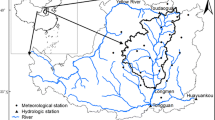Abstract
Both the climate change and human activities are the major influence factors to the sediment change in mountainous rivers. Based on the over 40 years’ record, suspended sediment loads (SSL) change at the Manhao gauging station in the lower reaches of Yuanjiang River (upper Red River). In this paper, the variation of the sediment and its drivers were analyzed through different methods such as synchronous data comparison, traditional correlation, linear regression, and Granger causality. The results show that (1) the general trend of the annual average sediment concentration (SSC) and SSL at Manhao station is increasing from the 1960s to the 1990s, and there is a quick change period after 1984; (2) the SSL and SSC at Manhao station, during different periods of the 1960s, 1970s, 1980s and 1990s, are 1.87, 2.49, 3.12, 3.63 kg/m3, and 28.7×106, 40.3×106, 44.1×106, 60.3×106 t/a, respectively; (3) the correlation analysis and the Granger causality test proved that the climate changes in the catchment were the main driving factors to the sediment variation in the period of 1960s and 1990s, but the influence by the mountainous human actions on the sediment change is stronger than that by the local climate changes in the 1970s and 1980s; (4) the correlation between the sediment changes and the forest coverage change is negative, which further proves that the sediment changes are strongly affected by the human activities in the basin.
Similar content being viewed by others
References
He D M, Fen Y, Hu J M, et al. Utilization of Water Resources and Environmental Conservation in the International Rivers, Southwest China (in Chinese). Beijing: Science Press, 2007. 61–175
He D M, Wu S H, Peng H, et al. A study of ecosystem changes in longitudinal range-gorge and transboundary eco-security in southwest China. Adv Earth Sci (in Chinese), 2005, 20(3): 338–344
Liu J Q, He R F. Temporal-spatial changes of water pollutants in mainstream of the Red River. Acta Geograph Sin, 1999, 54(supp.):146–151
Xie S Q. The hydrological characteristics of the Red River Basin, Hydrology (in Chinese), 2002, 22(4): 57–63
Bai S G, Fu H, Fang S D. Analysis of flood characteristics and statistical parameters in the Red River Basin. Hydrology (in Chinese), 2001, 21(4): 32–34
Luo Y S. Storm and flood characteristics of Chinese southwestern international rivers. Hydrology (in Chinese), 2000, 20(3): 59–62
Liu J Q, Zhang Y X, Wang L Q. Research on over boundary water quality problems of downstream of Yuanjiang-Honghe River and the protection, Yunnan Geograph Environ Res (in Chinese), 2005, 17(5):1–5
Lu P Z, Zhu T, He Y B. Water and soil erosion in Honghe River Basin. Yunnan Environ Sci (in Chinese), 2000, 19(1): 21–23
Van Maren D S. Water and sediment dynamics in the Red River mouth and adjacent coastal zone. J Asian Earth Sci, 2006, doi:10.1016/j.jseaes.2006.03.012
Van Maren D S, Hoekstra P L. Disperal of suspended sediments in the turbid and highly stratified Red River plume. Continent Shelf Res, 2005, 25: 503–519
Van DBGD, Van WTJCE, Boels J F, et al. Acoustical facies analysis at the Ba Lat Delta front (Red River Delta, North Vietnam). J Asian Earth Sci, 2006, doi: 10.1016/j.jseaes.2006.03.005
Yunnan Provincial Committee of Development and Planning, Yunnan Provincial Department of Land & Resources. Synthesis Investigation of Land and Resource in Yunnan Province Based on Remote Scene Technology (in Chinese), Kunming: Yunnan Science and Technology Press, 2004. 276–283
Fuller W A. Introduction to Statistical Time Series. New York: John Wiley, 1976. 373
Fu K D, He D M, Li S J. Response of downstream sediment to water resource development in mainstream of the Lancang River, Chin Sci Bull, 2006, 51(Suppl): 119–126
Xu J X. Sediment flux into the sea as influenced by the changing human activities and precipitation: example of the Huanghe River, China. Acta Oceanol Sin, 2003, 25(5): 125–135
Tang K L, Shi L R, Shi D M, et al. Water and Soil Conservation in China (in Chinese). Beijing: Science Press, 2004. 114–158
He D M, Feng Y, Gan S, et al. Transboundary hydrological effects of hydropower dam construction on the Lancang River. Chin Sci Bull, 2006, 51(Supp.): 16–24
Xu X L, Ma K M, Fu B J, et al. Research review of the relationship between vegetation and soil loss. Acta Ecolog Sin, 2006, 26(9):3138–3143
Synthetic Investigation Team of Water Diversion in Western China. Hydrological Geography in Western Sichuan and Northern Yunnan Region (in Chinese). Beijing: Science Press, 1985. 54–61
Author information
Authors and Affiliations
Corresponding author
Additional information
Supported by the National Key Project for Basic Research of China (Grand No. 2003CB415105)
About this article
Cite this article
He, D., Ren, J., Fu, K. et al. Sediment change under climate changes and human activities in the Yuanjiang-Red River Basin. Chin. Sci. Bull. 52 (Suppl 2), 164–171 (2007). https://doi.org/10.1007/s11434-007-7010-8
Received:
Accepted:
Issue Date:
DOI: https://doi.org/10.1007/s11434-007-7010-8




